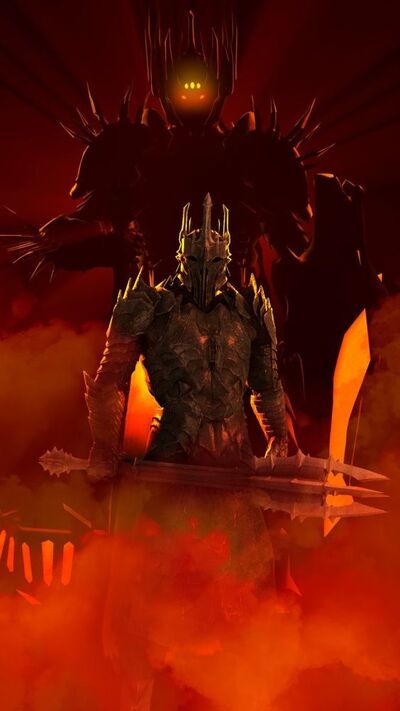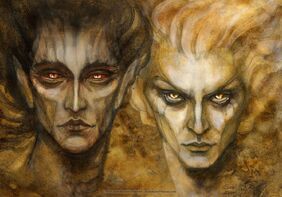
- "Indeed in nothing is the power of the Dark Lord more clearly shown than in the estrangement that divides all those who still oppose him"
- —Haldir, The Fellowship of the Ring, "Lothlórien"
Dark Lord, or Dark Power,[1][2] was the title held by the two most powerful tyrants of Arda, each of whom worked to subjugate Middle-earth and destroy or enslave the Free Peoples.
History
The first Dark Lord was the rebel Vala Melkor, later known as Morgoth. In the beginning, Melkor desired "the kingship of Manwë"[3] over Arda and to create beings with independent wills as Ilúvatar did. Denied both demiurgic power and dominion, Melkor, becoming Morgoth, eventually descended into nihilistic madness: he sought to mar Arda and to destroy both Elves and Men.
The second Dark Lord was Morgoth's servant, who would go on to be his successor, the subversive Maia Sauron, originally named Mairon.[4] Believing that "the Valar (including Melkor)" had failed, Sauron initially sought to bring order and heal the desolate lands of Middle-earth. But he began to lust for the "Complete Power"[5], that was Ilúvatar's, and sought to dominate all life and rule over the world as a "God-king"[6].

Both fallen Ainur were very influential in the history of Middle-earth, waging numerous wars against the Valar and the Free Peoples, and corrupting many to their side. Their actions had a permanent negative impact on the world, as both Dark Powers destroyed many beautiful things and places, and caused untold anguish and grief.
Morgoth had a profound influence on Sauron, as he was the first Dark Lord, and he had corrupted Sauron into betraying the Valar and serving his cause. Sauron learned a great deal from Morgoth, as he employed certain methods that Morgoth had used to gain influence and power.
Eventually, both Dark Powers were overthrown and defeated. Morgoth was banished to the Void at the end of the First Age by his brethren for his crimes. Sauron was first defeated at the end of the Second Age when Isildur cut the One Ring (that Sauron forged) from his hand, causing his spirit to go into hiding for many years. While Sauron made his return in the Third Age, he was permanently weakened for good at the end of the Third Age by Frodo Baggins, with the aid of Samwise Gamgee and unwittingly Gollum, when they cast the One Ring into Mount Doom, ultimately stripping Sauron of his power and influence, while also making him a permanent shadow.
No one was left to gather and command any remaining forces of Darkness in Sauron's absence: his duplicitous servant, Saruman, was the only one that could have conceivably claimed the title, and even "cheated [his] new master"[7] in attempt to usurp him. But he was defeated and lost his physical body after the Battle of Bywater, at the end of the War of the Ring.
Background & influence
In The Silmarillion, it is revealed that Sauron was the second Dark Lord and that the first was Morgoth with Sauron actually having been his vassal. Unwilling to accept his status as a mere sub-creator, Morgoth resolved to mar all creation and destroy the Free Peoples. When Morgoth fell, Sauron escaped the judgment of the Valar and arose as his successor, or "Morgoth returned", seeking to establish his own dominion over Middle-earth, and even Númenor.[8][9]
"Dark Lords" became a common trope in fantasy and science fiction following the success of J.R.R. Tolkien's The Lord of the Rings with the Dark Lord Sauron. A prominent example which closely mirrors the Morgoth and Sauron relationship is Darth Vader in the Star Wars franchise who like Sauron is the more well-known pupil of earlier "dark lord", Emperor Palpatine. The title "Sith Lord" is also synonymous with Dark Lord, which is both used in context for the Sith in Star Wars. Furthermore, the title "Dark Lord of the Sith" is given to the Sith Masters who govern over an Empire or several Apprentices, Emperor Palpatine was referred to as Dark Lord of the Sith. Vader's reluctant service to the Emperor in the Star Wars series also mirrors Saruman's, whose true goal is to betray his new master to become the "dark lord".
Later, Lord Voldemort, the primary antagonist of the Harry Potter series, is frequently referred to as the "Dark Lord" by both his followers and his enemies.
Translations
| Foreign Language | Translated name |
| Afrikaans | Donker Heer |
| Albanian | Zoti Errët |
| Amharic | ደማቅ ጌታ |
| Arabic | سيد الظلام |
| Armenian | Խավարի Տիրակալ |
| Azerbaijani | Qaranlıq Hökmdar |
| Basque | Ilun Jauna |
| Belarusian Cyrillic | цёмны Лорд |
| Bengali | ডার্ক লর্ড |
| Bosnian | Gospodar Tame |
| Bulgarian Cyrillic | Тъмен лорд |
| Cambodian | ព្រះអម្ចាស់ងងឹត |
| Catalan | Senyor Fosc |
| Cebuano | Mangitngit nga Ginoo |
| Chinese | 黑暗领主 |
| Cornish | Arlodh Tewal |
| Croatian | Mračni Gospodar |
| Czech | Temný pán |
| Danish | Mørk Herre |
| Dari | استاد تاریک |
| Dutch | Donkere Heer |
| Esperanto | Malluma Sinjoro |
| Estonian | Tume Isand |
| Faroese | Myrkt Harra |
| Fijian | Turaga ni butobuto |
| Filipino | Madilim Panginoon |
| Finnish | Musta Ruhtinas |
| French | Seigneur des Ténèbres |
| Frisian | Tsjustere Hear (Western) |
| Galician | Lorde Escuro |
| Georgian | ბნელი ბატონი |
| German | Dunkler Herrscher |
| Greek | Σκοτεινός Άρχοντας |
| Gujarati | ડાર્ક ભગવાન |
| Haitian Creole | Fènwa Seyè a |
| Hebrew | אדון האופל |
| Hindi | अंधेरे प्रभु |
| Hmong | Tsaus Tswv |
| Hungarian | Sötét Nagyúr |
| Icelandic | Myrkur Lávarður |
| Indonesian | Penguasa kegelapan |
| Irish Gaelic | Tiarna Dorcha |
| Italian | Signore Oscuro |
| Japanese | ダークロード |
| Kannada | ಡಾರ್ಕ್ ಲಾರ್ಡ್ |
| Kapampangan | Matuling a Ginu |
| Kazakh | қараңғы Лорд (Cyrillic) Qarañğı lord (Latin) |
| Korean | 다크로드 |
| Kurdish | Tarî Xudan (Kurmanji) |
| Kyrgyz Cyrillic | Кара Лорд |
| Latin | Dominus tenebrarum |
| Latvian | Tumsas pavēlnieks |
| Lithuanian | Tamsos Valdovas |
| Luxembourgish | Donkel Här |
| Macedonian Cyrillic | Темен Господар |
| Malayalam | ഇരുണ്ട രക്ഷിതാവ് |
| Manx | Hiarn Dorraghey |
| Marathi | गडद स्वामी |
| Mongolian Cyrillic | Харанхуй Эзэн |
| Nepalese | गाढा प्रभु |
| Northern Sami | Seavdnjat Isit |
| Norwegian | Mørk Herre |
| Old English | Deorc Hlāford |
| Pashto | تياره رب |
| Persian | ارباب تاریک |
| Polish | Czarny Pan |
| Portuguese | Senhor das Trevas |
| Punjabi | ਹਨੇਰੇ ਨੂੰ ਪ੍ਰਭੂ |
| Romanian | Lordul Întunecat (Seniorul Întunecimii) |
| Romansh | Stgir Dumagnar ? |
| Russian | Тёмный Властелин |
| Samoan | Pogisa Alii |
| Sanskrit | डेरिका नाथ ? |
| Scottish Gaelic | Dorcha Thighearn |
| Serbian | Тамни владар (Cyrillic) Gospodar tame (Latin) |
| Sesotho | Morena Lefifi |
| Sindhi | اونداهي پالڻھار |
| Sinhalese | අඳුරේ අධිපතියා |
| Slovak | Temný pán |
| Slovenian | Temni gospodar |
| Somali | Mugdi ah Rabbiga |
| Spanish | Señor Oscuro |
| Sundanese | Poék Gusti |
| Swahili | Giza Bwana |
| Swedish | Mörk Herre |
| Tajik Cyrillic | торик Худованд |
| Tamil | இருண்ட இறைவன் |
| Telugu | డార్క్ లార్డ్ |
| Thai | เจ้าแห่งศาสตร์มืด |
| Turkish | Karanlık Efendi |
| Ukrainian Cyrillic | Темний лорд |
| Urdu | اندھیرے کے رب |
| Uzbek | Қоронғи ҳазратлари (Cyrillic) Qorong'i hazratlari (Latin) |
| Vietnamese | Chúa tể bóng tối |
| Welsh | Arglwydd y Tywyllwch |
| Xhosa | Ebumnyameni Nkosi |
| Yiddish | דאַרק האר |
| Yoruba | Dudu Oluwa |
| Zulu | Nkosi webumnyama |
References
- ↑ The Silmarillion, Index of Names
- ↑ The Letters of J. R. R. Tolkien, Letter 144
- ↑ The Silmarillion, "Ainulindalë"
- ↑ Parma Eldalamberon, Words, Phrases and Passages in Various Tongues in The Lord of the Rings by J.R.R. Tolkien
- ↑ The Letters of J. R. R. Tolkien, "Letter 131"
- ↑ The Letters of J. R. R. Tolkien, "Letter 184"
- ↑ The Two Towers, "The Voice of Saruman"
- ↑ Unfinished Tales, Part Two: The Second Age, II: "Aldarion and Erendis: The Mariner's Wife"
- ↑ The History of Middle-earth, Vol X: Morgoth's Ring, Part Five: Myths Transformed